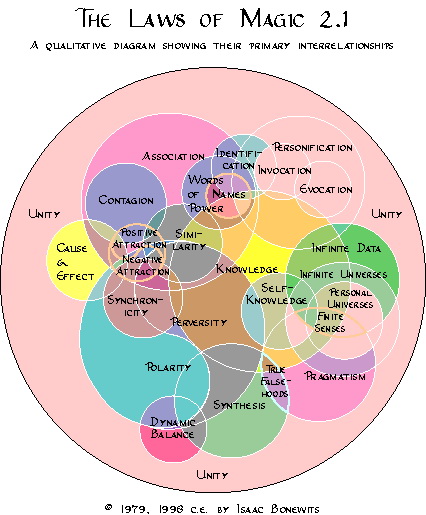
The Nature of these Laws and vice versa
We are now ready to go into a description of the basic ways in which magical phenomena seem to behave. The Laws of Magic are not legislative laws but, like those of physics or of musical harmony, are practical observations that have been accumulating over the course of thousands of years, with remarkable similarity in almost every known human culture. Those of you who prefer to remain skeptical as to the reality of psychic phenomena and the systems of magic developed to control them will at least find these Laws an interesting and detailed guide to what psychologists and anthropologists so patronizingly refer to as “magical thinking.”
Those of you who play magicians as characters will find these Laws a remarkably concise guide to the ways in Because I really can’t rewrite my first book all over again in this slim text, I’m not going to give the long explanation of each law. You can consult the works in the Bibliography (especially Real Magic and its Bibliography) for details if you wish.
Along with each Law listed, I’ll include “key words” to help in memorization. These phrases are gross generalizations, but have the advantage of being brief and easy to remember.
It’s entirely possible that there are other Laws of Magic, however, I’m currently unaware of any that are held to by most magicians on this planet.
The Law of Knowledge
Essence: Understanding brings control; the more that is known about a subject, the easier it is to exercise control over it.
Remarks: This Law is so fundamental that hardly any work on magic has ever been published without mentioning it. The comments in Chivalry & Sorcery are quite appropriate here: “The Magick User might be compared to a combination philosopher-sage-research scientist only those activities which directly aim at increasing one’s mastery of Magick itself can give the magician any ‘experience’ worthwhile to him.” These comments are most accurate for intellectual magicians of the theurgical sort but are more or less true of most other magic users as well.
Keywords: “Knowledge is power.”
The Law of Self-Knowledge
Essence: The most important kind of magical knowledge is about oneself; familiarity with one’s own strengths and weaknesses is vital to success as a magician.
Remarks: Most magicians quickly discover their own flairs and flaws. After all, this is a large part of what Apprenticeship is all about. This is also why “Evil Magicians” are comparatively rare in the real world (especially in the “higher ranks”) because a dedication to “Evil for Evil’s sake” is almost always due to a lack of introspection and self-awareness.
Keywords: “Know thyself.”
The Law of Cause & Effect
Essence: if exactly the same actions are done under exactly the same conditions, they will usually be associated with exactly the same “results;” similar strings of events produce similar outcomes.
Remarks: Magicians have at least as much belief in cause and effect as modern physicists do they just know that a good ritual, like a good poem or a good bread recipe, isn’t always absolutely predictable.
Keywords: “Control every variable and you control every change lotsa luck!”
The Law of Synchronicity
Essence: Two or more events happening at the same time are likely to have more associations in common than the merely temporal; very few events ever really happen in isolation from nearby events.
Remarks: If you manage to pin a professional debunker against a wall (be careful, they get nasty when cornered) you’ll find that the word “coincidence” is a Scientistic term of exorcism, used to banish the demons of non-material, and therefore “unscientific,” causality.
Keywords: “Coincidence is seldom mere.”
The Law of Association
Essence: if any two or more patterns have elements in common, the patterns interact “through” those common elements, and control of one pattern facilitates control over the other(s), depending (among other factors) upon the number, type and duration of common elements involved.
Remarks: This is probably one of the most important of the magical Laws and is directly connected to most of the others.
Keywords: “Commonality controls.”
The Law of Similarity
Essence: Effects are liable to have an outward physical or mental “appearance” similar to their causes.
Remarks: Having an accurate image/sound/smell of an object or being facilitates control over it or them.
Keywords: “Look-alikes are alike.”
The Law of Contagion
Essence: Objects or beings in physical or psychic contact with each other continue to interact after separation.
Remarks: Everyone your character has ever touched has a psychic link with him, though it is (probably) pretty weak unless the contact was intense and/or repeated frequently. Naturally having a part of someone’s body (nails, hair, spit, blood, etc.) gives the best contagion link. Almost as good are objects of clothing, handkerchiefs, bedsheets, etc., that have absorbed sweat or other bodily fluids from the being your character wishes to magically influence.
Keywords: “Magic is contagious.”
The Law of Positive Attraction
Essence: Like attracts like; to create a particular reality you must put out energy of a similar sort.
Remarks: This Law is often used in attraction spells, by saturating the aura of the magician or client with symbols and energies similar to those wanted. It’s also commonly cited for moralistic purposes to discourage unwanted magical behavior (see Chapter 11), on the grounds that behaving badly will attract evil or bad luck. This Law may refer to “morphic resonances;” the tendency for energy shapes to complete themselves, or perhaps “wave entrainment,” which is the ability of particular vibrations to set up matching vibrations in nearby energy patterns. If either of these phenomena happen with psychic energy fields, they could easily cause the effects usually referred to by this Law.
Keywords: “That which is sent, returns.”
The Law of Negative Attraction
Essence: Like attracts unlike; energy and actions often attract their “opposites.”
Remarks: People say that like attracts like, but they also say that opposites attract. This paradox can be reconciled by contemplating the classic “yin-yang” symbol. The two halves of the yin-yang are opposite in color, but they are identical in shape; thus opposite and similar on two different levels of reality (or universes of discourse). Yet the two halves both attract and repel each other in an eternal circular dance (see the Law of Polarity below).
Any phenomenon more complex than a bacteria can be viewed on several levels, so you can usually find ways in which any two phenomena can be seen as either opposite or similar, depending on which of these Laws of Attraction you are interested in emphasizing.
The reason this hasn’t been clear before is that Western Dualism usually picks one aspect of existence that two phenomena have and insist that it is the only “important” aspect as far as judging the phenomena to be similar or opposite.
Keywords: “Opposites attract.”
[Special note for webviewers: these two laws were not included in previous writings and lectures I have done over the years, precisely because I couldn’t reconcile the conflicting reports about magical attraction until I understood that this area overlaps the Laws of Perversity, Polarity and Attraction in the complex ways symbolized in the new chart of the laws.]
The Law of Names
Essence: Knowing the complete and true name of an object, being or process gives one complete control over it.
Remarks: This works because a name is a definition (yes, even “Harold,” “Marie,” “Xunte,” and “Jasmine” were at one time) as well as a contagion link. Perhaps more importantly, it works because knowing the complete and “true” name of something or someone means that you have achieved a complete understanding of its or his nature. This is why, in most pre-industrial cultures, people are given “secret names” as well as “public names,” and why the sharing of a secret name is such an act of trust because the secret name is considered to be very close to, if not identical with, the person’s true name.
Keywords: “What’s in a name? Everything!”
The Law of Words of Power
Essence: There exist certain words that are able to alter the internal and external realities of those uttering them, and their power may rest in the very sounds of the words as much as in their meanings.
Remarks: Many words are names and most have known definitions. Barbarous words of power are (currently, if not originally) nonsense words that nonetheless can release certain psychic phenomena and states. Very many magical tools require words to be in-scribed upon them and/or to be said over them during their creation.
Keywords: “A word to the wise is sufficient.”
The Law of Personification
Essence: Any phenomenon may be considered to be alive and to have a personality, that is, to “be” an entity or being, and may be effectively dealt with thusly.
Remarks: This Law is based on fundamental human thought processes and does make doing magic, especially with abstract concepts, much easier. Most magicians who do weather magic, for example, personify the winds and the clouds, and thus find focusing their APK upon the atmosphere much easier.
Keywords: “Anything can be a person.”
The Law of Invocation
Essence: It is possible to establish internal communication with entities from either inside or outside of oneself, said entities seeming to be inside of oneself during the communication process.
Remarks: Either Invocation or Evocation can control the spirit communication processes known as inspiration, conversation, channeling (mediumship), and temporary possession.
Keywords: “Beings within…”
The Law of Evocation
Essence: It is possible to establish external communication with entities from either inside or outside of oneself, said entities seeming to be outside of oneself during the communication process.
Remarks: Evocation is the Law that controls most summonings.
Keywords: “…Beings without.”
The Law of Identification
Essence: It is possible through maximum association between the elements of oneself and those of another being to actually become that being to the point of sharing its knowledge and weilding its power.
Remarks: This is the Law that controls most lengthy or permanent possession phenomena.
Keywords: “You can become another.”
The Law of Infinite Data
Essence: The number of phenomena to be known is infinite; one will never run out of things to learn.
Remarks: The best possible example of this is the Internet. You could spend 24 hours per day, seven days per week, and still never see 1% of the information that’s out there and most of human knowledge isn’t on the Net yet (as of 1998, anyway).
Keywords: “There’s always something new.”
The Law of Finite Senses
Essence: Every sense mechanism of every entity is limited by both range and type of data perceived.
Remarks: Many real phenomena exist which may be outside the sensory scanning ability of any given entity.
Keywords: “Nobody can see everything,” or “Just cause it’s invisible don’t mean it ain’t there.”
The Law of Personal Universes
Essence: Every sentient being lives in and quite possibly creates a unique universe which can never be 100% identical to that lived in by another.
Remarks: So-called “reality” is in fact a matter of consensus opinions. There is no single “Reality” that exists whether people like it or not that odd idea is popular due to monotheistic theologies and the Scientism they spawned instead there are multiple and frequently contradictory realities all existing simultaneously. This Law may or may not be the same as the
Law of Infinite Universes.
Keywords: “You live in your cosmos and I’ll live in mine.”
The Law of Infinite Universes
Essence: The total number of universes into which all possible combinations of existing phenomena could be organized is infinite.
Remarks: Some people consider this Law to refer to the “alternate probability worlds” of science fiction, however, it has a much wider application.
Keywords: “All things are possible, though some are more probable than others.”
The Law of Pragmatism
Essence: If a pattern of belief or behavior enables a being to survive and to accomplish chosen goals, than that belief or behavior is “true” or “real” or “sensible” on whatever levels of reality are involved.
Keywords: “If it works, it’s true.”
The Law of True Falsehoods
Essence: It’s possible for a concept or act to violate the truth patterns of a given universe (including an individual’s or group’s part of a consensus reality) and yet to still be “true,” provided that it “works” in a specific context.
Remarks: A data pattern may be true on one “level of reality” and false on another, depending upon the circumstances involved. For example, on the normal scholarly level of reality the Thunder Gods are parts of the “quaint mythologies of our ignorant ancestors” and therefore “false,” but on the level of reality involved in magical Rain-Making They are very real indeed.
Keywords: “If it’s a paradox it’s probably true.”
The Law of Synthesis
Essence: The synthesis of two or more “opposing” patterns of data will produce a new pattern that will be “truer” than either of the first ones were, that is, it will be applicable to more realities (or “levels of reality”).
Remarks: This new pattern will not necessarily be a compromise but may be something new.
Keywords: “Synthesis reconciles.”
The Law of Polarity
Essence: Any pattern of data can be split into (at least) two patterns with “opposing” characteristics, and each will contain the essence of the other within itself.
Remarks: Polarity should not be confused with dualism, a mistake that Westerners have been making for four thousand years and which has quite possibly led to more all-around misery than any other theological concept in history (see Chapter 11). Dualism assumes that opposites are at war with one another; polarity assumes that they embrace. The creators of D&D did the game world a major favor when they made “neutrality” a part of the political and moral alignments in their game. The “Law vs. Chaos” and “Good vs. Evil” alignment systems so common in fantasy games are dangerous oversimplifications but the addition of “neutrality” and “amorality” (not to mention the new alignments that have been invented by players and referees, such as “hungry,” “weird,” or “whimsical”) have added far more creativity in character creation and play.
Keywords: “Everything contains its opposite.”
The Law of Dynamic Balance
Essence: To survive, let alone to become powerful, one must keep every aspect of one’s universe(s) in a state of dynamic balance with every other one; extremism is dangerous on both the personal and the evolutionary levels of reality.
Keywords: “Dance to the music.”
The Law of Perversity
Essence: also known as “Murphy’s Law,” “Finagle’s Law,” etc.: if anything can go wrong, it will and in the most annoying manner possible.
Remarks: Magical associations sometimes operate in the reverse of what was wanted; meaningful coincidences are just as likely to be unpleasant as they are to be helpful (especially if a lot of emotion goes into the related situations). Even if “nothing can possibly go wrong,” some element of the universe may change so that things will go wrong anyway.
This Law is probably based on the use of countermagic by one’s own subconscious mind, for whatever devious or even neurotic reasons it may have. My guess is that it also ties in with the Anti-Psi talents. This Law explains why some people’s magic seems to work backwards. Emotionally healthy magicians have less problems with this Law than unhealthy ones do, and once a magician has reached the Master/Mistress rank his “klutz factor” tends to go down accordingly. The klutz factor (or “fumble factor”) is used by many referees to dampen down the effectiveness of high-level magicians who are unbalancing their game universes, but it has a basis in fact as well as in game playability.
Keywords: These can only be, “If anything can go wrong, it will.”
The Law of Unity
Essence: Every phenomenon in existence is linked directly or indirectly to every other one, past, present or future; perceived separations between phenomena are based on incomplete sensing and/or thinking.
Keywords: “All is One.”
Copyright © 1979, 1998 c.e., Isaac Bonewits








